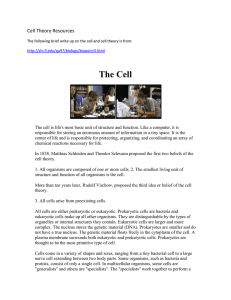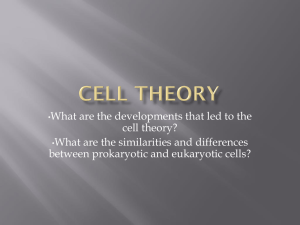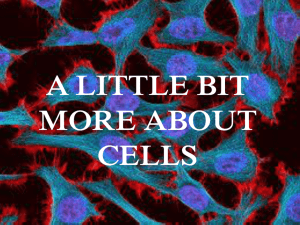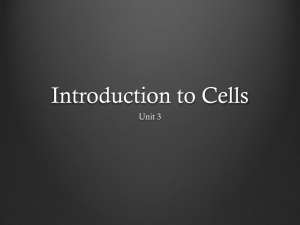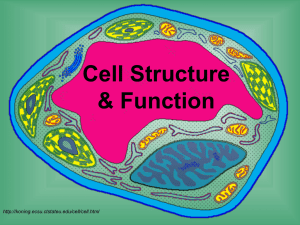MITOCW | MIT7_01SCF11_track04_300k.mp4
advertisement
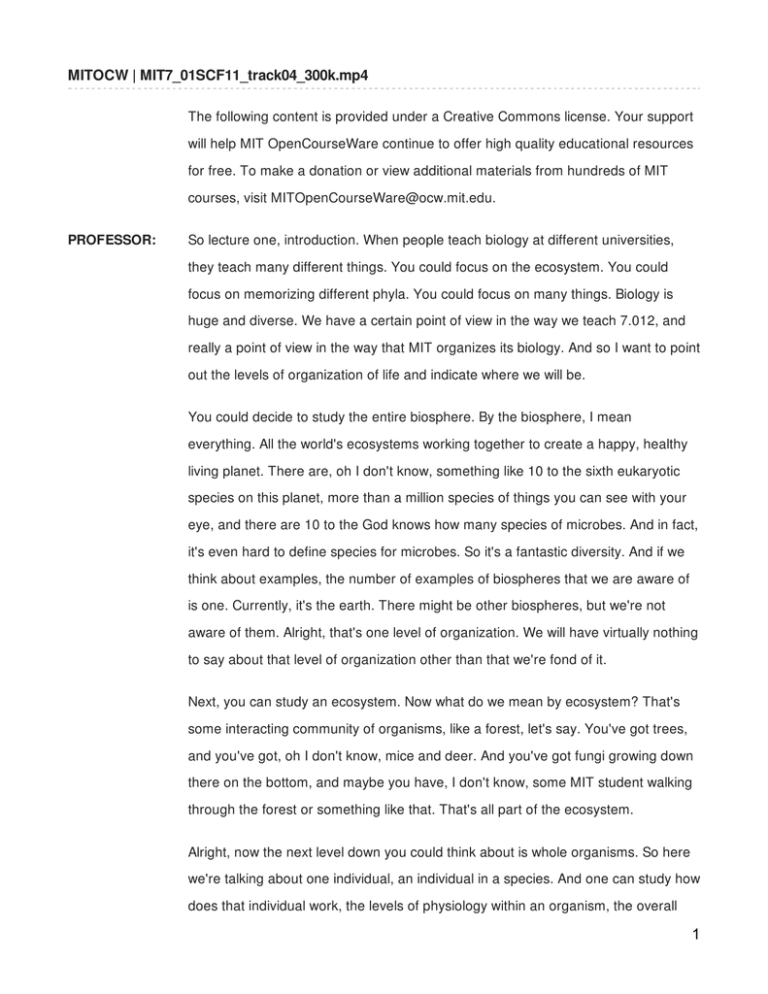
MITOCW | MIT7_01SCF11_track04_300k.mp4 The following content is provided under a Creative Commons license. Your support will help MIT OpenCourseWare continue to offer high quality educational resources for free. To make a donation or view additional materials from hundreds of MIT courses, visit MITOpenCourseWare@ocw.mit.edu. PROFESSOR: So lecture one, introduction. When people teach biology at different universities, they teach many different things. You could focus on the ecosystem. You could focus on memorizing different phyla. You could focus on many things. Biology is huge and diverse. We have a certain point of view in the way we teach 7.012, and really a point of view in the way that MIT organizes its biology. And so I want to point out the levels of organization of life and indicate where we will be. You could decide to study the entire biosphere. By the biosphere, I mean everything. All the world's ecosystems working together to create a happy, healthy living planet. There are, oh I don't know, something like 10 to the sixth eukaryotic species on this planet, more than a million species of things you can see with your eye, and there are 10 to the God knows how many species of microbes. And in fact, it's even hard to define species for microbes. So it's a fantastic diversity. And if we think about examples, the number of examples of biospheres that we are aware of is one. Currently, it's the earth. There might be other biospheres, but we're not aware of them. Alright, that's one level of organization. We will have virtually nothing to say about that level of organization other than that we're fond of it. Next, you can study an ecosystem. Now what do we mean by ecosystem? That's some interacting community of organisms, like a forest, let's say. You've got trees, and you've got, oh I don't know, mice and deer. And you've got fungi growing down there on the bottom, and maybe you have, I don't know, some MIT student walking through the forest or something like that. That's all part of the ecosystem. Alright, now the next level down you could think about is whole organisms. So here we're talking about one individual, an individual in a species. And one can study how does that individual work, the levels of physiology within an organism, the overall 1 integration of signals, the distribution of oxygen across the body, things like that. This is a popular topic to study. We'll have a little bit to say about physiology, but that won't be our major focus, that whole organismal level of physiology. Example of an organism, say a human, in particular, let's say an MIT student. OK. Next up, we could study an individual organ. So by an organ, I'm thinking about some part of the organism that's a group of tissues that are organized together to carry out a function. So it's a group of tissues that are organized to carry out a function. And we have the eye, the eye on that human. So we've got these muscles here. We've got some photoreceptors there on the back, and they send back nerve terminals going there. All these tissues working together to provide vision. OK. Going down one level below that we have tissues. These are more homogeneous groups of cells. So we could have, say, the retina. Then those tissues are made up of cells. So cells of course are bounded by a membrane. They have nuclei, at least in eukaryotes. So let's say within the retina, we could pick a photoreceptor cell. So the MIT student is walking through the forest and with her eye is getting light on the retina, which is triggering photoreceptor cells. They each have a distinctive shape, and that shape-- there's our nucleus. The light comes and impinges there, sends a signal out the other end. OK. That's a cell. Then we get down to organelles. These are distinct components within a cell. For example, this photoreceptor is using up a lot of energy. It has mitochondria. These mitochondria in here are involved in producing efficiently ATP. And then finally, we have molecules. A wide variety of different molecules in the cell: sugars and DNA's and-- but I'll say ATP will be our example here. Molecules. So if you think about it, we have sets of levels of organization, all the way up there from biospheres to ecosystems to organisms to organs to tissues to cells to organelles to molecules. And biology thinks about all of those different levels, and in principle, they all interact. Of course, it's somewhat hard to keep in mind, say, the connection between the entire biosphere and a ATP at any given point. It's a bunch of levels going up and down. At MIT, we tend to focus more on the bottom of the 2 picture than the top of the picture, and that's what this class will focus on. You run the risk that you'll forget there is a top of the picture, that there are ecosystems, there are organisms, physiology and all that. Oh well. What can I say? Why do we focus the bottom of the picture? Why do we focus so much on, say, the molecules of life? You're going to get a lot of molecules of life in the beginning of this course. We're going to focus on-- we'll think about organelles and cells. You'll hear less about tissues, less about organs, less about organisms as a whole. And the reason is life is most universal down at its bottom. That is what's shared across all life. Rather than, say, focus on the glorious, wonderful differences between all the different phyla and learning all sorts of genuses and of all sorts of interesting-- we want to focus on that which is most universal. Now, there are some differences. We will look differently at microbe, prokaryotes versus eukaryotes and all. But for the most part, what we're trying to do is ask what are universal principles that apply across all organisms? What are the ways organisms are built up? Commonalities, like the genetic code, that applies pretty broadly across all organisms, commonalities of signalling systems, regulatory systems. Things like that are what we're most interested in, because once you learn that, it's much easier to layer on top of it the differences, the unique differences, that makes a fruit fly a fruit fly or a tree a tree. So anyway, that's our perspective on it, and I hope you like it. But it's the only prospective we've got, so there you go. Next, a few dates to keep in mind. Important dates in the history of life. Again to provide perspective, we're not going to focus on lots of them, but a few that you should know. About 4.0 billion years ago-- BYA means billion years ago-- the earth cooled. Before that, it was a hot, molten mass. There until it cooled, there was no real prospect of life. One of the things I find absolutely wonderful is that by 3.7 billion years ago, there was clear evidence of the first life. Whatever it was, it didn't take that all long to get life going. Somehow, it can't be that hard, although I got to say we don't quite understand all of it. Increasingly, people are looking back to how early life can form out of prebiotic materials. And these things were prokaryotic organisms, like bacteria, and they played a very important role, for example, in changing the entire atmosphere of the earth to contain oxygen, which made 3 possible other things. So-- sorry, in shaping the content of oxygen in the atmosphere. So 1.5 billion years ago, one has a totally amazing invention, which is the first nucleated cells. These bacteria lack nuclei. Here we have nucleated cells, eukaryotes. Major event, and it occurred because of a fusion of two of these prokaryotic-type cells. One takes up residence in the other, and there is a symbiosis between two cells and that gave rise to your nucleus. The one that lives inside the other eventually discarded most of its functions there. Sorry-- yes, that gave rise to a nucleated cell. It's a fusion between two different prokaryotic organisms that had different properties, one of which is the nucleated cell, the other of which you see in the mitochondria, for example. There's still a genome in the mitochondria, for example. And so we can recognize that there was this prokaryotic fusion event. Notice it took 2 billion years, more than two billion years, to make eukaryotes and only 300 million years to make the first life. I find that quite remarkable. What does that tell us? That it was that much harder to make a eukaryotic cell. Maybe. Or maybe it tells us about the power of competition. Once you have some life-- that the first prokaryotic cells-- it's so much harder to get anything else that can come in and compete with it, because it has to be better. Maybe the first life didn't have to compete with anything, and it was easy. And then in an innovation like the eukaryotic cell, well, maybe that was a lot harder to accomplish, because it had to be better than the prokaryotic cells it was competing with. I'm not sure, but I find that difference in time to be kind of a remarkably interesting thing. That that was short, and that took a lot longer. 0.5 billion years ago, roughly speaking, what you have are multicellular organisms with body plans. Up to this point, you have single-celled organisms. Now you get multicellular organisms with body plans. And another remarkable thing, once body plans, multicellular body plans, are invented, they explode very quickly. Somehow it was hard to invent multicellularity, to get cells to work together and be an organism, but once it was invented, it was not hard to diversify it into zillions of different body plans and forms. That tells us something. That as soon as we see multicellularity, 4 we start seeing huge numbers of different body plans pretty quickly. Very interesting. A few other important dates. Two other dates. 0.005 billion years ago are humans. Just to put yourself in your place on this scale. And 0.00000015 billion years ago, MIT was founded. Just to put this in prospective. Alright. Couple of other things you should know. The types of cells I've been referring to. There's really two fundamental types of cells. And I've been using the word already. Let me just get it out there. Prokaryotes. Eukaryotes. Karyo refers to nucleus. Eu- means true. Pro- means primitive, before. So eukaryotic cells-- you're, by the way, a eukaryote. Right? Just in case you haven't read the owner's manual, you're eukaryotes. --have true nuclei. Inside the nucleus, there's your DNA, which is organized better than I just drew it there, because, in fact, it's very, very long and has to be packed up well. It'll have organelles like mitochondria. It could have chloroplasts. It could have other organelles. It'll have other things we'll talk about-Golgi apparatuses and endoplasmic reticula and all that. Bacteria don't have a true nucleus. It's not that they're DNA isn't somehow organized, but it doesn't have a true nucleus with the wall around it. There's no wall around that nucleus like that. They often have interesting cell walls. A striking thing, although I've drawn them as the same size, these are much smaller. These are 1 to 2 microns. These, 10 to 40 microns in diameter. And so that means that if we talk about volume, we cube it. So the volumes of these guys are something like 1,000 to 60,000 times bigger. Eukaryotic cells are large compared to prokaryotic cells. Now, remember these are the guys who were early. These guys come along later. And there are important differences that we'll talk about in eukaryotic and prokaryotic cells. You're a eukaryote, all animals, all plants are eukaryotes. Fungi, such as yeast, et cetera. 5


